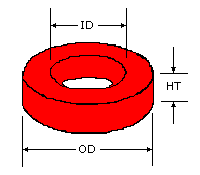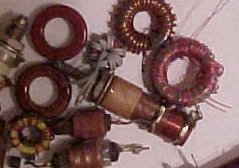

This site is hosted at WebWizards.Net for better value.
Don't leave this valuable site without visiting my book shop to see my recommendations. This helps keep this site FREE for everyone.
YOU ARE HERE: HOME > BASICS > TOROIDS
These come in two types. Powdered Iron or Ferrites. Both introduce permeability, that means an increased inductance for a given number of turns. Toroids look exactly like doughnuts and come in various diameters, thicknesses, permeabilities and types depending upon the requency range of interest. Note the correct spelling, not torroids
1. High inductance for the physical space occupied.
2. No interaction or coupling with adjacent components (unlike air wound and other inductors).
3. Various permeabilities are available.
4. Exceptional Q values when wound correctly and optimum core and windings selected.
5. Wide range of diameters and thicknesses.
6. Relatively low cost
7. Often simple to mount or secure mechanically.
1. Nearly impossible to introduce variable tuning of the inductance.
2. Subject to some thermal drift.
Fig 1. - Toroid Core A typically popular type is made available by Micrometals and a representative example is the T50-2. This core is lacquered red (so you know the type) and has the following main properties.
Being T50 it's outside diameter is 0.5", the ID is 0.3" and the thickness
is 0.19"
The permeabilities or in this case AL factors i.e. ( inductance
per 100 turns2 ) are:
TYPE
COLOR AL
Freq. Range
T50-26 Yel-Wh
320uH
power freq.
This is only a small sample to give you an idea. Your turns required
to give a certain inductance based on the above AL is
as follows:
N = 100 * Ö[ L / AL] Therefore to obtain an inductance of 3.685 uH using a T50-6 toroid would
require 28 turns (of course I cheated again) but check it out on your calculator
as I may have left in a deliberate mistake to see if you're awake.
By the way don't get too paranoid about the exact number
of turns because cores do vary in value anyway and particularly with temperature
changes.
I finally got around to photographing some coils and toroids.
Figure 2 - photograph of some coils and toroids Sorry for the poor lighting. The top two toroids on the left are T68-2 types (red). Below that is the yellow T50-6 type. To the right of the yellow toroid are two RFC (radio frequency chokes) one is 1 mH and the other is 2.5 mH. Above the RFC, lying diagonally, is a 4.7 uH (nominal) variable inductor from J.W. Miller. At the extreme left of the photo is the tip of a similar variable inductor where the tuning screw is a little more clearer.
Finally to the middle right is a wound toroid I salvaged from somewhere.
Mike Czuhajewski has this excellent chart for toroids, print it out.
See: Mike's Toroid Chart
A considerable amount of work has been done by Roy Lewallen, W7EL on the important topic of mounting toroids.
It is quite often important in applications such as LC filters to preserve "Q" as high as possible. Roy has done quite a lot of research in this area.
In part, Roy says...
"Of the materials tested, both types of RTV stand out as having a negligible effect on inductor Q. Hot melt glue and paraffin have a small enough effect that they should be tolerable for many applications. Duco cement seriously degrades Q, even in a much thinner layer than the other coatings. The "sealing tape", tested out of curiosity, shows just how great a degradation can be caused by a poor coating........."
See: http://www.qrp.pops.net/w7el.htm
FREE Micrometals RF design software, RF-Toroid was written as a supplement to the Micrometals RF Application catalog. Much emphasis was put into calculating the location of the Self resonate frequencies for series and shunt inductors. RF-Toroid is for use DC to 300 MHz. Much research went in to the calculation and corrections from the standard formulas for low perm & phenolic cores to better predict the RF style of winding and application.
Some features include SRF for series and shunt cores, peak Q curve ranges and 200 & 360 degree coverage to achieve the best product possible for the microwave designer who needs accurate and abundant information at the finger tips to compare one core to another simultaneously. The custom core feature allows for custom shaped cores, stacking cores side by side , ferrite cores and machining custom phenolic cores from plastic, wood, ect... Micrometals hope this tool will serve you well.
Download Micrometals RF Design Software - 397Kb
Go to Micrometals Inductor Design Software for other inductor software.
PLEASE NOTE:The toroid part numbers mentioned herein and elsewhere on my sites are copyright © Micrometals, Inc.
My very good friend Dieter (DIZ) Gentzow - W8DIZ - of Loveland, Ohio, tells me, "as far as I know, my prices for Toroids are the best in town/county/world :)"
Diz goes on to say "the web page with the info is at... http://www.kitsandparts.com/toroids.html"
I'm sure Diz will look after you kindly.
NEW! - How to link directly to this page
Copy and paste the following code for a text link:
and it should appear like this:
This site is hosted at WebWizards.Net for better value.
As you would imagine maintaining this site costs me considerable sums of money in many, many ways. If you believe this site is a valuable and FREE educational resource and, YOU want to keep it that way, then here's how YOU can demonstrate your very practical support for this site..
Thanks to these fine folks making voluntary donations, ensuring this site and our Newsletter remains FREE. Could YOU be listed here for your small contribution in return for your FREE education?. Our grateful thanks.
Please send me your valuable comments and suggestions! Tell your friends, tell a news group, tell your favourite magazine, heck tell the world!
Absolutely essential to keeping abreast of new and updated electronics tutorials is our comments or subscribe to our highly regarded FREE monthly newsletter form. Unsubscribe any time you like. You can view immediate past issues here to see if it is to your liking.
YOU ARE HERE: HOME > BASICS > TOROIDS
the author Ian C. Purdie, VK2TIP of www.electronics-tutorials.com asserts the moral right to
be identified as the author of this web site and all contents herein. Copyright © 2000, all rights reserved. See copying and links.
These electronic tutorials are provided for individual private use and the author assumes no liability whatsoever for the application, use, misuse, of any of these projects or electronics tutorials that may result in the direct or indirect damage or loss that comes from these projects or tutorials. All materials are provided for free private and public use.
Copyright © 2000 - 2001, all rights reserved. URL - www.electronics-tutorials.com/basics/toroids.htm
Updated 13th August, 2001
webmaster@electronics-tutorials.com
What are toroids?
Some of the advantages of toroids are:
Some of the disadvantages of toroids are:

T50-3 Gray
175
50 Khz to 500 Khz
T50-1 Blue
100
500 Khz to 5 Mhz
T50-2 Red
57
2 Mhz to 30 Mhz
T50-6 Yellow
47
10 to 50 Mhz
T50-10 Black
32
30 to 100 Mhz

Mike Czuhajewski WA8MCQ has produced a Toroid Chart
Mounting Toroids
Micrometals RF Design Software
Micrometals Inductor Design Software
Inexpensive source of Toroids in USA
Link to this page
Want to create a page link to me from your site? It couldn't be easier. No HTML knowledge required; even the technophobes can do it. All you need to do is copy and paste, the following code. All links are greatly appreciated; I sincerely thank you for your support.
<a href="http://www.electronics-tutorials.com/basics/toroids.htm" target="_top">visit Ian Purdie VK2TIP's "Toroids" Page</a>
visit Ian Purdie VK2TIP's "Toroids" Page
CARE TO BE A PRACTICAL SUPPORTER OF THIS SITE?

Related topics on inductance
1. audio transformers
2. chokes
3. coil formers and cores
4. inductive reactance
5. mobius winding techniques
6. power supply transformers
7. toroid cores
8. wide band rf transformers
Commercial use prohibited without prior written permission from www.electronics-tutorials.com.